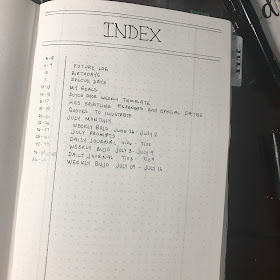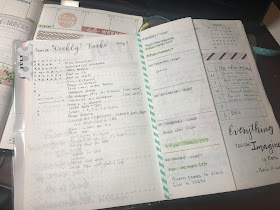Welcome to my bullet journal! I just started my 6th journal this month so I wanted to share my setup. The picture you see above is my cover. I use a Seven Seas Crossfield* journal which is a dotted 480-page journal with Tomoe River Paper (used in Hobonichi journals)
*The design of the Crossfield has chanaged and I no longer recommend this product.
As much as I love my iPhone for everything, I found that it's calendar and todo feature wasn't working for me. Using the analog system helped me to remember appointments and be more productive and organized. So I assume you already know the basics of bullet journaling. So I will show you the various components.
Index
The index is the key to bullet journaling. As I mentioned, I use my journal for everything - weekly and daily planning, daily art and journaling, lesson planning, meeting notes, etc. So I may be on page 65 which may be a daily art journal page and the next page may be meeting notes. The index keepts track of everything so that I can find what I'm looking for. My index isn't very exciting but I do keep this updated.
Future Log
Unlike a traditional planner where each month/week is prepared ahead of time for you to fill in, a bullet journal is supposed to be immediate, meaning that you prepare each day as you come to it. I do some preplanning so that I prepare my week ahead, but I prepare one week at a time, usually on the weekends. That means that you need a place to hold information for upcoming months. As a teacher, this is really important because I need to know when vacations are and other breaks so I can plan my lessons.
I organize my future log in three month chunks. Each column on the left represent a month and I write down the day and the description so when I'm planning the next month, I just look down the column to see what I have scheduled. I've used this system for about a year and love it.
My Goals
At the end of each year, I try to create my goals for the next year. For me, my goals have not changed much over the years. But if you notice the bullets under each goal. Those may change from year to year. I am always trying to learn and be a better version of myself.
Monthly Layout
Until recently, I've always used the traditional calendar layout for my months. But currently, I'm using a modified version of the original monthly layout developed by Ryder Carroll.
I write the date and the corresponding day of the week along the left column. The red dotted line separate the weeks. I write my main goals for the month on the right and include a short quote. I wasn't sure if I would like this format because I'm so visual, but it's been working for me so far.
Weekly/Daily
The basic format for my week/daily has not changed. I've changed the number of pages I use and other cosmetic things but the core remains. I use a Dutch door system so that I can see my weekly schedule on top and I have pages that represent each day.
I have a weekly section first, that I write down main goals for the week, dinner menu for Monday through Sunday (and if you notice, I only have one S for sunday since we usually go out on Saturdays.) Throughout the week, I fill in the memories section, something I want to remember for each child. Some people have weekly tracker that tracks certain habits. For me, creating trackers was far more time-consuming than beneficial, so I now have "This week I..." section. I just write down things that I accomplished or things that I want to document for the week. I'm much more likely write my progress toward a goal this way.
So as you can see, the weekly schedule is above. when you turn the weekly page, you see...
The weekly schedule is still visible. I write in what I need to accomplish each day. When I'm not teaching, I use two days/page. But during the school year, I use one page per day.
I use half the page for lesson planning and any notes. The time bar on the left side of each page was my attempt at documenting how I spent each day, but I've since abandoned that. I'm not sure if I will use this layout when school starts, but it will be some variation of it.
For the first two weeks in this new journal, I tried a different weekly/daily layout. The rationale was that many of my bulleted items from day to day got migrated or were the same. I thought perhaps a running log of my weekly tasks would be a better format. And I still wanted to wanted to be able to see my week and be able to plan lessons. So I came up with the following layout (with a lot of looking online for inspiration.)
I still used the Dutch door system, but this is a vertical one. On the left, you see my running log of weekly tasks or notes. And the top of the log was all the tasks that I do daily. It ended up becoming a tracker. I still could see the weekly schedule and if you flip that page, you'd see my lesson plan (I taught summer school.) I still had room for weekly menu and memories. This takes very little time preparing, but I didn't like it. I missed using Washi tape and I wan'ted room to write notes. So that is why I'm back to my old layout.
The symbols used are defined in my Key. Most people will start the bullet journal with their key. My key is a laminated sheet that I also use as a pencil board (to put under the page you're working on so that pen impression won't be transferred to the next page. I used to use it as young child in Japan.)
This will require modification once school starts again in August since our schedule has changed.
Daily Journal
I try to journal everyday, usually accompanied by an illustration. This month, I'm following two challenges, one for World Watercolor Month and another for Boho Berry Challenge, which is a journaling challenge. This is what I usually share on Instagram.
Collections
Collections are pages that you create that can have multiple uses. It can be a spread that lists books you want to read, quotes that you want to illustrate, meeting notes, birthdays you want to remember, etc. The beauty of collections in a bullet journal is that when you fill up a spread, you can continue the collection on another page and you just keept track in the index.
I have a collection called Quotes to Illustrate. I still have room for more quotes, but when I run out of space, I will start another spread and will add the new page numbers to my origianl entry in the index for this spread. I have other collections and some of them may migrate from book to book.
I will a tab for Bullet Journal in the home page so that if you are only interested in seeing how my bullet journal evolves, you can skip all the art journal part.















I believe I've said this before, Angelcake, but your ability to organize stuff is awesomely awesome! My son has laughed at me for arranging my dvd and cd collections alphabetically, but that's as far as I go. I wish I had the uncontrollable cleaning form of O.C.D., but, alas, no. Life is so unfair.
ReplyDeleteI have yo force myself to be organized because I'm really a mess! Lol...
DeleteI've tried different ways to organize my life and so far this system works for me!
Good for you, Ms Kari! I'm in so much pain and discomfort these days that I've decided to own my messiness (yeah, that's the reason).
DeleteBy the way, I love the new picture. You seem to be aging backwards.
Tinted In a Tinted In a Tinted In a Tinted In a Tinted In a Tinted In
ReplyDeleteTinted In a Tinted In a Tinted In a Tinted In a Tinted In a Tinted In a titanium quartz Tinted In a Tinted titanium max In a Tinted titanium phone case In a Tinted In a Tinted citizen titanium watch In a Tinted In a Tinted titanium necklace mens In a